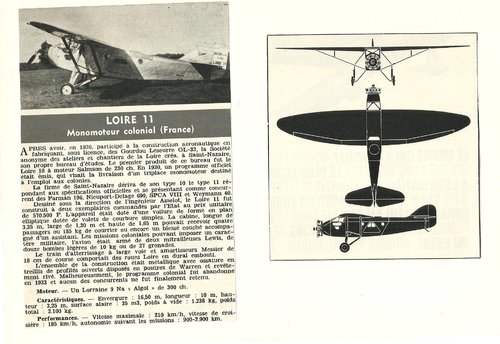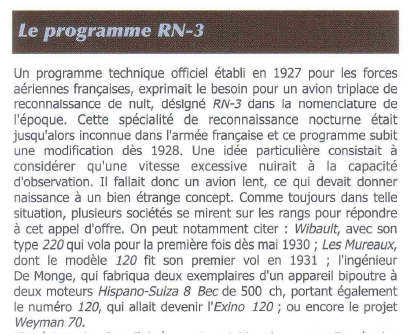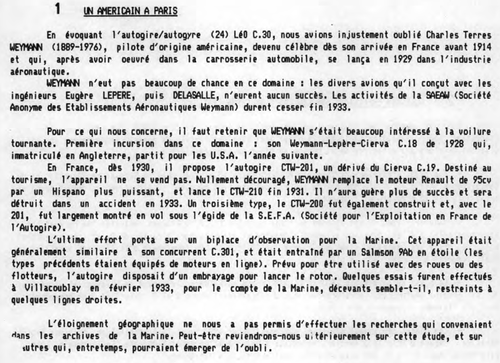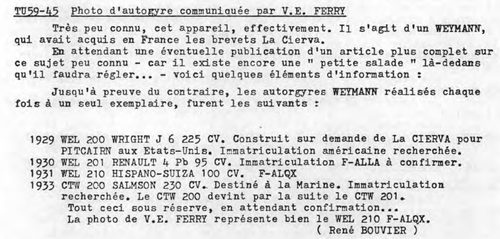- Joined
- 26 May 2006
- Messages
- 34,911
- Reaction score
- 15,788
Hi,
Mr. Charles Terres Weymann was born in Haiti,and became a French pilot and designer after moved to France,he
made some aircraft and Projects,until he opened Société des Avions Weymann-Lepère in 1929,and his list was as
following;
WEL-10 was a two-seat parasol wing recce monoplane,powered by one 650 hp Hispano-Suiza 12Nb engine
WEL-11 was a two-seat parasol wing observation monoplane,developed from WEL-10
CTW-20 was a the same as Lepere/Cierva C.18,need confirm
WEL-30 ------?
WEL-40 was a colonial transport aircraft Project,intended to compete in 1930 competition
WEL-50 was a high-wing tourist monoplane,powered by one 95 hp Renault 4Pb pusher engine,mounted on pylon
WEL-51 was a development of WEL-50,ordered in two prototypes but never completed,need confirm
WEL-52 was a refined version of WEL-50,also a tourist aircraft
WEL-60 was a three engined colonial transport high-wing monoplane of 1930,powered by three 250 hp Wright-Hispano 9 Qa engines
WEL-63 was a three engined colonial/transport high-wing monoplane,need confirm;
CTW-66 was a three-seat colonial aircraft,powered by three 300 hp Lorraine 9Na engines
WEL-70 was a three-seat night recce aircraft Project,intended for RN.3 contest
WEL-80 was a two-seat recce biplane aircraft,powered by one 650 hp Hispano-Suiza 12Nb engine
WEL-81 was a two-seat recce biplane,derivative of WEL-80,need confirm
WEL-90 ------?
CTW-100 was a three-seat recce biplane developed from WEL-80,powered by one 575 hp Hispano-Suiza 9Va engine
CTW-110 ------?
CTW-120 ------?
CTW-130 was a two-seat tourist biplane aircraft,powered by one 95 hp Renault 4Pb engine
CTW-131 was a modified version of CTW-130 as a tourist aircraft,powered by 150 hp Hispano-Suiza 5Q engine
CTW-132 was a light and tourist aircraft,based on CTW-130,need confirm
CTW-140 to CTW-190 ------?,probably not used
WEL-200 was a two-seat autogiro built on request of La Cierva for Pitcairn in the United States,powered by one 225 hp Wright J 6 engine,1929
WEL-201 was a two-seat autogiro,powered by one 95 hp Renault 4 Pb engine,1930
CTW-200 was a two-seat tourist autogiro,powered by one 100 hp Renault 6Pa engine,1933
CTW-201 was a two-seat tourist autogiro,derivative of Cierva C.19/3,powered by one 95 hp Renault 5Pb engine
CTW-210 was a two-seat tourist autogiro,powered by one 100 hp Hispano-Suiza 6Pa engine
CTW-220 ------?
CTW-230 & CTW-231 was a two-seat tourist biplane aircraft,powered by one 100 hp Hispano-Suiza 6Pa engine
- the early aircraft and Projects will illustrate later
Mr. Charles Terres Weymann was born in Haiti,and became a French pilot and designer after moved to France,he
made some aircraft and Projects,until he opened Société des Avions Weymann-Lepère in 1929,and his list was as
following;
WEL-10 was a two-seat parasol wing recce monoplane,powered by one 650 hp Hispano-Suiza 12Nb engine
WEL-11 was a two-seat parasol wing observation monoplane,developed from WEL-10
CTW-20 was a the same as Lepere/Cierva C.18,need confirm
WEL-30 ------?
WEL-40 was a colonial transport aircraft Project,intended to compete in 1930 competition
WEL-50 was a high-wing tourist monoplane,powered by one 95 hp Renault 4Pb pusher engine,mounted on pylon
WEL-51 was a development of WEL-50,ordered in two prototypes but never completed,need confirm
WEL-52 was a refined version of WEL-50,also a tourist aircraft
WEL-60 was a three engined colonial transport high-wing monoplane of 1930,powered by three 250 hp Wright-Hispano 9 Qa engines
WEL-63 was a three engined colonial/transport high-wing monoplane,need confirm;
CTW-66 was a three-seat colonial aircraft,powered by three 300 hp Lorraine 9Na engines
WEL-70 was a three-seat night recce aircraft Project,intended for RN.3 contest
WEL-80 was a two-seat recce biplane aircraft,powered by one 650 hp Hispano-Suiza 12Nb engine
WEL-81 was a two-seat recce biplane,derivative of WEL-80,need confirm
WEL-90 ------?
CTW-100 was a three-seat recce biplane developed from WEL-80,powered by one 575 hp Hispano-Suiza 9Va engine
CTW-110 ------?
CTW-120 ------?
CTW-130 was a two-seat tourist biplane aircraft,powered by one 95 hp Renault 4Pb engine
CTW-131 was a modified version of CTW-130 as a tourist aircraft,powered by 150 hp Hispano-Suiza 5Q engine
CTW-132 was a light and tourist aircraft,based on CTW-130,need confirm
CTW-140 to CTW-190 ------?,probably not used
WEL-200 was a two-seat autogiro built on request of La Cierva for Pitcairn in the United States,powered by one 225 hp Wright J 6 engine,1929
WEL-201 was a two-seat autogiro,powered by one 95 hp Renault 4 Pb engine,1930
CTW-200 was a two-seat tourist autogiro,powered by one 100 hp Renault 6Pa engine,1933
CTW-201 was a two-seat tourist autogiro,derivative of Cierva C.19/3,powered by one 95 hp Renault 5Pb engine
CTW-210 was a two-seat tourist autogiro,powered by one 100 hp Hispano-Suiza 6Pa engine
CTW-220 ------?
CTW-230 & CTW-231 was a two-seat tourist biplane aircraft,powered by one 100 hp Hispano-Suiza 6Pa engine
- the early aircraft and Projects will illustrate later
Last edited:




